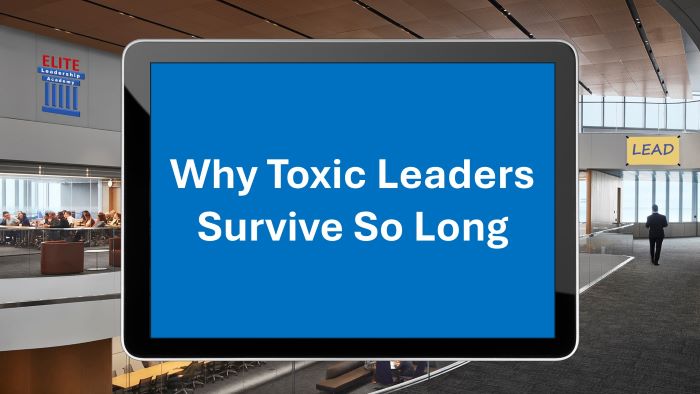Every year, I enjoy watching TV shows and movies about the holiday season. It’s a tradition I started with my kids when they were young and continue to this day either by myself or when they arrive for the holidays. Some of my favorites include, “A Charlie Brown Christmas”, “It’s a Wonderful Life” and even “Die Hard.” I also like to watch the animated “How the Grinch Stole Christmas,” but this year, I decided to also watch the 2000 live version of “How the Grinch Stole Christmas” with Jim Carrey. The animated version is my favorite, as I’ve read the book to my kids several times when they were young and even tried to imitate Boris Karloff at times. As I was watching it, I saw several parallels to toxic leadership that I’ve been writing and speaking about lately. There are 4 points about the similarities to the Grinch and a toxic leader that I would like to share with you.
Continue reading “Don’t Let a Toxic Grinch Steal Your Christmas or Your 2026 Profitability!”Why Toxic Leaders Survive So Long
People frequently ask why toxic leaders survive in an organization. In this video, I explain some of the reasons.
Continue reading “Why Toxic Leaders Survive So Long”Toxic Leaders: The Silent Profit Leak in Organizations
In organizations, a single toxic leader can quietly drain far more value than a weak product line or a small market loss. Toxic leaders create fear, favoritism, and instability that erode morale, collaboration, and trust. Employees under these leaders report higher stress, lower satisfaction, and a greater intent to leave, which pushes your best people toward competitors who offer healthier environments.
Continue reading “Toxic Leaders: The Silent Profit Leak in Organizations”The 4 Seasons of Building a Winning Leadership Management Culture
If you’ve ever followed a sports team, you know their success isn’t accidental. Coaches and players think in seasons—each with a distinct purpose, each building toward a championship. There’s the preseason, where talent is evaluated. The regular season, where strategy and alignment determine success. The postseason, when only the highest performers rise. And finally, the offseason, when reflection fuels improvement.
Continue reading “The 4 Seasons of Building a Winning Leadership Management Culture”Transforming Nursing Leadership Utilization With LeadershipRM™ – A Case Study Brief
Overview
“Gott Health” (name changed for confidentiality), a fast-growing regional hospital system, faced a leadership challenge. With 20 facilities and over 5,000 nursing staff, the Chief Nursing Officer (CNO) was overwhelmed—managing 24 direct reports, well beyond the limit for effective leadership. Even after reducing the number to 13, she knew a more strategic solution was needed.
Continue reading “Transforming Nursing Leadership Utilization With LeadershipRM™ – A Case Study Brief”3 Costly Leadership Management Pain Points Requiring Immediate Attention
U.S. companies pour over $200 billion into leadership development each year—yet only 10% see real results, according to Harvard Business Review. There are numerous reasons why, but a contributing factor is probably because most organizations focus on developing leaders… but not managing them for sustainable growth.
Continue reading “3 Costly Leadership Management Pain Points Requiring Immediate Attention”Why Leadership is Your Organization’s Most Valuable Resource
If I were to ask you to name your organization’s most valuable resource, you would probably respond with innovation, technology/data, mineral resources or even your people or culture. People and culture are pretty close, but people usually thrive and like the working environment because of a good leader. Culture is also nourished and supported by a good leader. In fact, a good leader will help an organization maximize the value of all of their other resources.
Continue reading “Why Leadership is Your Organization’s Most Valuable Resource”Are Leaders Born or Made?
Please listen to my interview below on leadership on the Straight Outta Health IT podcast with Christopher Kunney. It’s also available directly on Apple and Spotify.
Continue reading “Are Leaders Born or Made?”Toxic Workplaces Survival Strategies
We all know that toxic leaders are prevalent in most organizations, regardless of the size and recognize the negative impact they can have on the individuals that work for them, as well as on their peers and other teams they encounter. What if the entire workplace is toxic? Individual toxic leaders can be identified and counselled to improve or move on. What if you find yourself in a toxic work environment? As much as we try to avoid them during a job search, we may inevitably find ourselves in one. This is not the result of a few individuals but stems from an entire workplace culture.
Continue reading “Toxic Workplaces Survival Strategies”The Impact of Toxic Leaders on Your Organization
Toxic leaders are like weeds in your garden or lawn. If you don’t remove them right away, they will infest your entire organization resulting in stifled growth, reduced morale and the departure of quality employees.
Toxic leaders are everywhere, whether organizations want to admit it or not. They can be found in organizations with as little as 100 employees or found in multitudes in larger ones. Unfortunately, they are usually ignored and allowed to choke the growth of those around them, namely, their subordinates and their peers. They are usually accepted and described in satisfactory terms such as hard-working, results-driven, or persistent. On the surface, these traits could describe great employees, but when taken to the extreme, they result in negative outcomes, such as abuse, intimidation and manipulation.
Continue reading “The Impact of Toxic Leaders on Your Organization”











